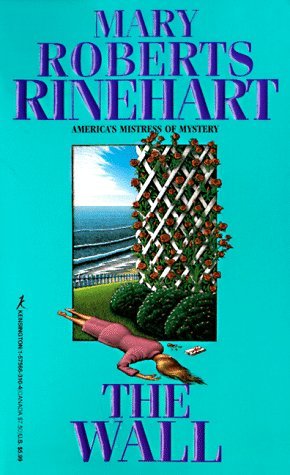Book Review: The Wall by Mary Roberts Rinehart
Marcia Lloyd is an upper-crust socialite who is not as wealthy as she used to be. Not by any means broke, but when she comes to her summer home, Sunset, in New England, she can only afford to employ a handful of servants for a house that needs a dozen or so. Still, Marcia is looking forward to a break from Depression-Era New York City–until she discovers that her brother Arthur’s ex-wife Juliette Ransom is in town. The conniving Juliette insists on staying at Sunset, being rather vague about her reasons for being on the island.
Juliette is known for her expensive tastes and fondness for playing with men’s affections, so it’s perhaps not too surprising when she goes out riding one day and never comes back. Some time later, her corpse turns up, and it’s pretty obviously it was murder. But who did it? Was it Marcia, our narrator? Arthur, who can no longer afford the ruinous alimony payments? The mysterious painter Allen Pell, who knows Juliette from somewhere but won’t say more? Any of the dozen or so men of “the summer people” Juliette partied with in the past. or perhaps a local? Or a complete stranger?
Mary Roberts Rinehart (1876-1958) was a prolific author perhaps best remembered for her mysteries; she was at one point known as “the American Agatha Christie.” This book is an example of the “Had I But Known” school of mystery writing, where a character (usually female) has incomplete information, or fails to grasp the significance of the information she has, and makes blunders that cause the mystery to be harder for the investigators to solve.
Marcia often mentions bits from further along in the story–“I did not know then who Juliette had seen in the town” and fails to get clues to the sheriff in a timely manner because she doesn’t realize they are clues. In the early part of the novel, she also doesn’t reveal what she knows about the activities of her brother Arthur as she’s trying to protect him, muddying the waters. But Marcia is scarcely the only one at fault, Arthur and several other male characters also make mistakes that tangle up the investigation to avoid scandal or pursue their own agendas. Plus the murderer is of course not telling the police anything.
The book is very much a period piece; not just because of the vanishing way of life Marcia and the “summer people” represent, but the little cultural references. For example, “Bank Night at the movies” is mentioned offhand. In 1938, Ms. Rinehart’s readers would have instantly understood; nowadays most readers will need to consult Wikipedia.
One amusing bit is that the house is wired with bells to summon servants, and these keep going off at random intervals when no one’s there, despite the electrician claiming all the wires are functioning correctly. Marcia tells us right up front that the bells have nothing to do with the mystery, and they are still unexplained at the end, even after the title of the book is finally explained. (This part may or may not be based on something that happened at Mary Roberts Rinehart’s real-life Maine summer house.)
There’s also a romantic subplot, as Marcia develops a thing for Allen Pell, and vice-versa, despite the very real possibility that he’s a multiple murderer.
Content issues: There’s a fair amount of classism, some period sexism, a couple of ethnic slurs and discussion of suicide. Marcia and most of the other characters smoke heavily and drink alcohol (overuse of alcohol leading to tragedy is a plot point.)
While not Ms. Rinehart’s best known work, this is a fun read if you are willing to put up with the characters acting rather stupidly and some twists that seem to come out of nowhere. Recommended for fans of old-fashioned mystery novels.



I have a tradition of reading an old (as in vintage, not something I’ve read before) mystery every year over the winter holidays. I think you’ve just directed me to the one I’ll be seeing if I can find.
Also recommended from Ms. Rinehart are “The Circular Staircase” and “The Bat.” (The latter played a part in inspiring Batman.)
Scott, you’re perception on motivation is delightfully uncanny. I particularly liked the way you described this style of mystery novel as “the “Had I But Known” school of mystery writing, where a character (usually female) has incomplete information, or fails to grasp the significance of the information she has, and makes blunders that cause the mystery to be harder for the investigators to solve.” You have a skill that is completely enchanting and quite likely have missed your calling as a very adept literary English professor.
Thanks!
I always enjoyed Agatha Christie novels as a kid. I think I read all of them. Thank you for the comprehensive review of the Stateside comparable.
Glad to help!
My question is, was it bad writing (that details were forgotten), or was it done intentionally to throw off the reader?
It’s intentional. The narrator is supposed to be fallible to be more relatable to the reader.
I agree with Kimberly – you do have a gift.
Funny about the bells not being explained. We had a bell that was originally pressed to summon the maid to clear the dining room. When we lived in the house it was pressed simply because it was there. The incessant ringing must have driven my poor parents crazy.
Are you familiar with the mystery books written by Louise Penny? She’s my current fave.
Checking Goodreads, it appears that I have not read any Louise Penny books. Which would you particularly recommend?